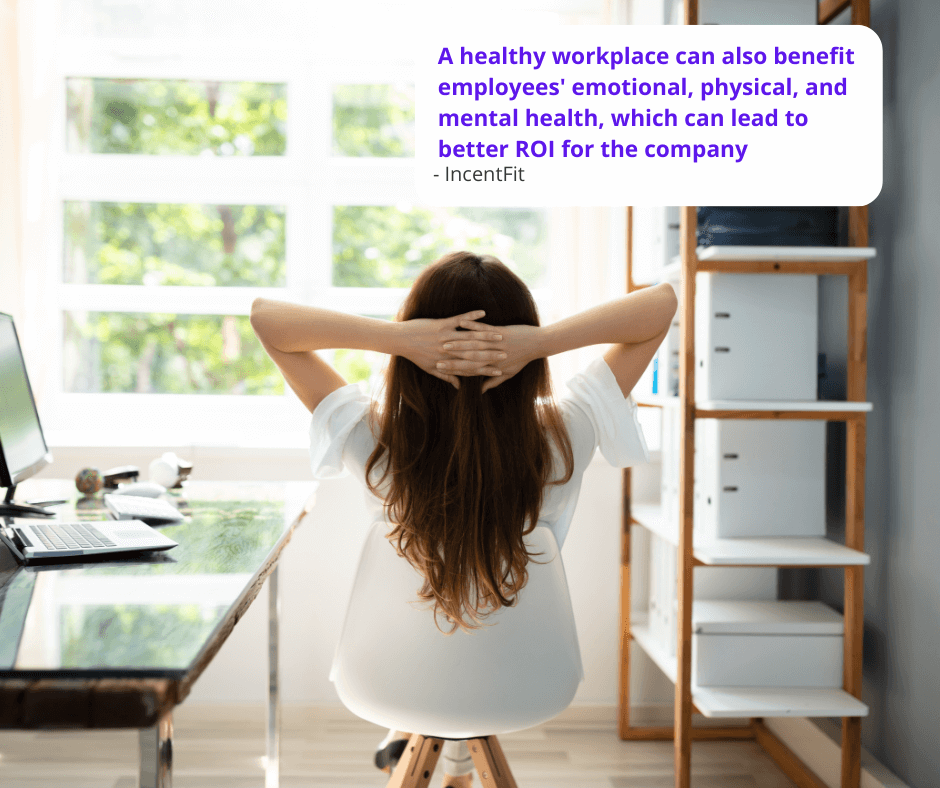5 Ways HR Can Encourage a Healthy WFH Lifestyle in 2023
Supporting and encouraging a healthy employee lifestyle
by Nick Schurk - February 10th, 2023
Maintaining a healthy lifestyle can be challenging enough, but trying to do it while remotely working feels impossible for many workers.
Remote work eliminates commuting for most people. While this may save them time, gas, and money, it can also mean less walking or cycling. Even a brisk ten minutes between the parking lot and your desk each way is better than nothing. And unfortunately, without the pressure of a commute, many employees might default to “nothing.”

When the transition to work is no longer clearly defined, and your “getting ready” process means simply moving from the bedroom to the coffee table, the boundaries between “work” and “rest” blur. This leads to more stress or longer hours.
Remote work makes it challenging to get into a routine or stretch your legs. You can’t just visit a coworker’s desk or make a coffee run, making it harder to determine when “work” is truly over.
Download Our State of Well-Being & Safety In HR Report
Given that, encouraging (and modeling) healthy employee lifestyles and habits can be a great way to improve how people feel at work – even while disconnected.
Just as it is harder to engage employees during the age of remote work, it may be challenging to encourage a healthy lifestyle in general from behind a screen. This article will serve as a resource for HR managers to better support and promote a healthy employee lifestyle, even from far away. This can mean anything from active lifestyle tips to mental health and beyond.
It’s important to check in with distributed team members to make sure they’re following healthy work habits. Be clear with expectations for your team and let them know how they can take a step back from work for their mental or physical health. This can be a delicate balance because too much “noticing” can make some team members feel like they’re being watched, so offer guidance gently.
5 Tips to Promote a Healthy Work-From-Home Routine
1. Start with Prevention
Promote wellness activities: Like Meditation Mondays or Yoga Fridays. While these activities shouldn’t be mandatory, sharing and allowing people to opt into these events can demonstrate a commitment to healthy lifestyles.
Continue to Allow flexible work: While this may not seem health-related, for many employees, it is! It leads to more walks, more time to cook healthier meals instead of opting for take-out, and a massive reduction in stress.
Share health insurance information: Robust health plans often come with benefits beyond the standard coverage, like EAP access or other perks. Be sure to highlight and share these benefits and how they can be utilized.

2. Ensure That You’re a Role Model
No late emails: Consider using an email scheduler if you find yourself on the clock at midnight. Employees feel pressured to adopt late work hours when they see leadership doing so – they’ll also feel pressured to respond immediately regardless of the time.
Think twice about virtual happy hours: How about Coffee Hours? Tea Hours? Think of ways to build camaraderie and connection that don’t involve alcohol, which can often come with some hidden or invisible pressures to partake.
Remember that actions speak louder than words: If employees see their leaders living work-first and health-later lifestyles, they’ll feel pressured to emulate those behaviors. By being a role model, you’re giving implicit permission for people to prioritize their health and wellness.
Don’t just say you support a healthy lifestyle. Prove it with the company’s values, beliefs, and actions. Model healthy behaviors by letting your employees know they should keep reasonable working hours, spend their free time actively, and plan their days off. Send newsletters in which you encourage them to take care of themselves. Remind them they don’t have to check emails or answer calls during their time off.
3. Encourage Physical Activity
Build in rest breaks and stopping points: Try not to book a calendar full of back-to-back meetings; instead, remember to account for human needs. Even setting meetings to 45 minutes instead of the default 60 minutes can help give people some breathing room to stretch their legs or take a water break on a busy day.
Share local races or walks for a health cause: If there are local walks or races for health issues, consider inviting team members to participate in these activities.
Consider additional benefits: How robust is your employee health plan? Many companies subsidize gym memberships and offer rewards for wellness activities (e.g., steps taken in a month). Some cover the costs of critical vaccines and other preventative health measures.
Meeting and bonding with colleagues over an actual task or game can inspire everyone on the team to maintain a mentally and physically healthy lifestyle. Dispersed and asynchronous teams offer exciting ways for team members to build healthy work-life balances, but meeting with colleagues in real life as often as possible, allows each of us to build stronger connections with one another, and improves the way we communicate and work with each other.
4. Don’t Forget about Mental Health
Create a company mental health plan: Mental health is as critical as physical health. The two often work in tandem and influence each other. Think about integrating mental health into the organization’s physical health plans. Encourage your team to take advantage of their EAP benefits or offer regular mental health days and well-being workshops,
Administer pulse checks: How are people feelings? Are they feeling engaged and connected or isolated and disconnected? Are they overwhelmed? Well-balanced? The best way to find out is to ask. Make it a routine to administer periodic pulse checks or engagement surveys – and even better, follow up on that data and take action when you see warning signs.
Encourage positive communication and leadership: All of the health and well-being initiatives in the world can’t overcome a negative leadership style. Offer training around positive leadership, positive communication, and organizational culture. It’ll go a long way.
Have a set budget for fitness classes and book them as a company for your team based on location. This allows team members to choose an activity of their choice, and they’re much more likely to appreciate and attend a class that aligns with their interests.
5. Try Virtual Wellness Activities
Consider corporate health applications: Digital apps can do anything from tracking people’s steps to helping them stay on top of wellness visits. They can help encourage entire companies and teams to prioritize their health.
Observe health-related awareness days: From Breast Cancer Awareness Month to World AIDS Day, observing and recognizing these days can encourage and foster an appreciation for employees whom these various illnesses may impact.
Share health articles and newsletters: This can be in the form of a weekly or monthly digest or a calendar.

GoCo can make all of these things more manageable. Since you can automate any HR checklist, you can use GoCo to create automated flows for employee engagement surveys, performance management, feedback, and more. With this, you can easily engage the employee, ask for feedback and see how you can better support a healthy lifestyle.
This isn’t just limited to pulse checks and surveys, either. Digitizing your processes helps support a healthier work-life balance. Employees won’t spend as much time on manual or administrative work, nor will HR. HR can automate processes through the GoCo platform to focus on employee engagement programs instead.
Recommended Posts
8 Ways to Expand Mental Health & Well-Being at Work
Blog Articles
How To Prevent Employee Burnout
Blog Articles
Search...
Product
GoCo
Resources
Articles
eBooks
Webinars
Customer Stories



